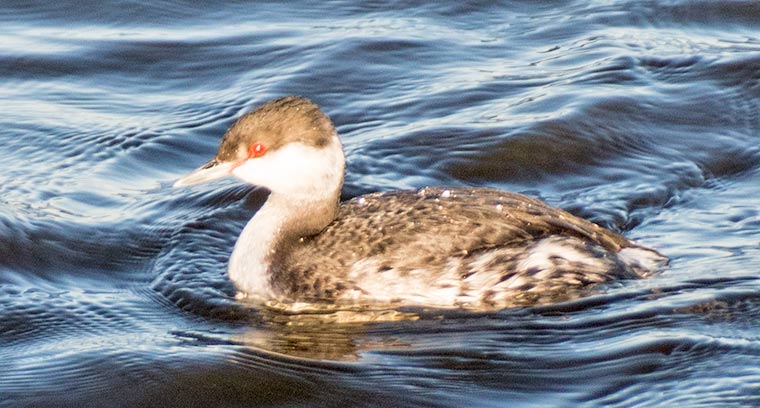We spent the Thanksgiving Holiday on the South Carolina coast. The weather was great, but a bit windy for outdoor photography.
While walking along the Battery in Charleston, we saw a group of four grebes paddling around offshore. They were diving periodically, searching for something to eat. Water drops can still be seen on this one’s back. Grebes are almost more aquatic than aerial. Often they prefer to elude predators by diving and swimming underwater rather than flying. Their legs are placed far back on their body, so that they are not very good on land. But they are excellent swimmers. Grebe feathers are only partially waterproofed so they can achieve neutral buoyancy and do not have to expend energy just to stay down.
Grebes do not have webbed feet as do ducks and geese. Rather they have fleshy lobes on the sides of their toes. It used to be thought that grebe feet were more “primitive” structures than were webbed feet. Well, it seems that grebes have the last laugh. Recent studies have shown that grebes move their feet in circles perpendicular to their direction of swimming instead of paddling parallel to the direction of travel as do ducks and geese. In this way grebe’s feet generate “lift” in a manner similar to the movement of an airplane propeller through the air. Their feet with the lobed toes thus act as hydrofoils and enable them to swim very efficiently.
These four birds we saw were Horned Grebes (Podiceps aurites). They are only about 12 inches long. We get to see this species here in the South only in the Winter. They breed in the North: Canada, Alaska, a small sliver of the northern U.S. and much of northern Eurasia. In Europe and Asia, this species of often called the Slavonian Grebe. After Fall migration, we see some of the North American portion of the population in the Southeastern U.S. Although the bird shown above is quite handsome, it will put on a much more spectacular set of clothes for the breeding season. Some fine pictures of Horned Grebes in breeding plumage can be seen at the Cornell Laboratory of Ornithology website. There you can see the tufts of feathers on their heads that inspired their common name of Horned Grebe.

